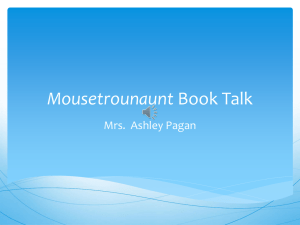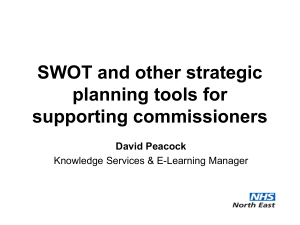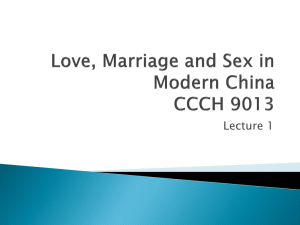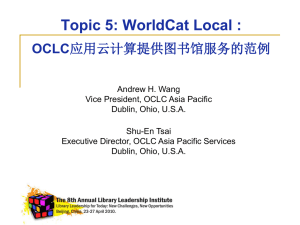Outline 概要 - HKU Libraries
advertisement
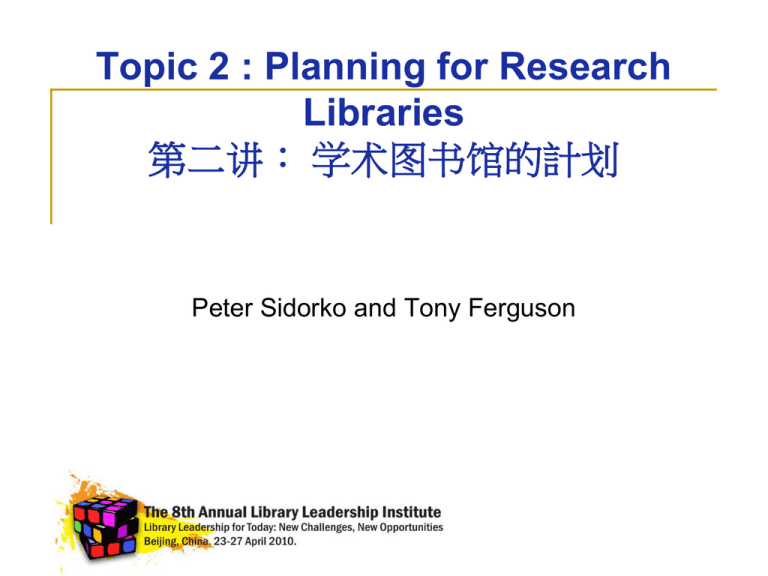
Topic 2 : Planning for Research Libraries 第二讲: 学术图书馆的計划 Peter Sidorko and Tony Ferguson Outline 概要 Planning 计划 Strategic planning 策略规划 Environmental Scanning 环境扫描 Environmental Scanning Examples 环境扫描范例 Group Assignment 小组作业 2 Planning 计划 Planning 计划 Planning is the conscious predetermination of courses of action. 计划是有意识的预定行动 方案 Making things happen that may not have. 使可能不会发生的事情发 生 Attempting to control the future. 尝试控制未来 The function of everybody in the library. 图书馆所有人的职能 A process of logical decision making 合逻辑的决策过程 4 Planning for 拟定计划 Direction Consistency Innovation Action Efficiency Performance Evaluation Change 方向 一致性 创新 行动 效率 绩效 评估 转变 5 Strategic planning 策略规划 Strategic planning 策略规划 Strategic planning is a model of planning that places greater emphasis on creativity, innovation and intuition, where events are anticipated rather than reacted to. 策略规划是一个侧重于创造,创新和直觉的计划 模式,在此过程中,我们会对事情作出预测而不 是作出反应。 7 Strategic planning 策略规划 Strategic Planning is a long-term approach, and incorporates the library’s missions statements in determining the library’s future direction and the strategies and resources required to make progress towards mission achievement. 策略规划是一项长期计划,在计划图书馆的未来 方向和策略,以及达成使命需要的资源时,会配 合图书馆的使命宣言。 8 Strategic planning steps 策略规划步骤 基本规则 (参与、工作小组、 Establish the ground rules 进度表等等) (participation, task force, timeline, etc) Develop mission statement 立下使命宣言 Conduct an environmental analysis (eg, PETS) 进行环境分析( 例如,政治、 经济、技术及社会文化) Resource analysis (strengths, weaknesses - SWOT) 资源分析 (优劣机危) Identify strategic issues (library’s future) 找出策略议题 (图书馆的未来) Define future strategies (where library is going) Decide on programs (how to get there – projects) Implement and plan to evaluate (success?) 定出未来策略 (图书馆往哪 走?) 定出方案 (如何到达那裹 ─ 各项计划) 实行和计划评估 (成功与否?) 9 Strategic planning elements 策略规划的要素 Mission 使命 Vision 愿景 Goals 目的 Objectives 目标 Actions, change and innovation through Projects 透过项目而来的行动,转变和创新 10 The Mission 使命 Establishes the purpose of the organisation: 确定机构存在的目的 ? Why does the library exist? 图书馆为甚么会存在? The Mission 使命 What is the company’s business? Who are the customers? 何为机构的业务性质? 谁是顾客? What is our value to the customer? (Drucker) 何为我们的顾客价值? (Drucker) Guides the actions of the organization 组织行动的指引 Defines its primary goal Gives direction 确立基本目标 提供方向 Environmental scanning 环境扫描 Effective planning can only be done if you know the environment in which your library operates! 只有充份了解图书馆的运作环境, 有效计划才可达成 Environmental scanning 环境扫描 Libraries operate in unique environments 图书馆在独特的环境中 运作 These affect the way a library performs, the services it provides and the markets in which they operate. 这些环境会影响图书馆 的表现、提供的服务及 运作的市场。 As these evolve, their impact will vary over time. 由于环境的演变,其影 响将随时间而变。 Therefore, it is necessary to scan the environment regularly. 因此,我们需定期地分 析环境。 14 PETS Environmental Scan 环境扫瞄 Political Economic Technological Socio-cultural 政治 经济 技术 社会文化 15 PETS Environmental Scan 环境扫瞄 These 4 areas will impact the way an oganisation performs, the services/products it provides and the markets in which they operate. 这四项因素会影响组织 的运作方法,提供的服 务或产品以及其营运市 场. As these are evolving, their impact will vary over time. 由于这些因素不断地演 进,其影响亦会随不同 时期而转变。 16 How to do a library environmental scan 图书馆怎样做环境扫瞄 Find someone else who has done it (eg, OCLC) 找一个曾做过环境扫瞄机构 (例如:OCLC) Maintain awareness of professional developments 保持对专业发展的认识 Maintain political awareness (local and beyond) 保持政治觉知性(本地及以 外的) Attend conferences, courses, seminars etc 参加会议,课程,研讨会 Talk to colleagues 与同事讨论 Read lots 多阅读 Look at what the competition is 看看竞争环境 – 开放地借鉴 doing – borrow liberally. 17 Environmental Scan Examples 环境扫瞄範例 2003 OCLC Environmental Scan: Pattern Recognition 2003 OCLC 的环境透视:认清前景趋势 “provides a high-level view of the information landscape, intended both to inform and stimulate discussion about future strategic directions” 「对信息状况发表深入的见解, 以期让读者了解未来策 略的方向并激励这方面 的讨论」 1. Research & learning (Political) landscape 1. 研究和教学状况 2. Social landscape 2. 社会状况 3. Economic landscape 3. 经济状况 4. Technology landscape 4. 技术状况 http://www.oclc.org/reports/escan/ 19 Horizon Report (2010): Key trends 主要趋势 The abundance of information resources challenges the way education must perform its business. People expect to be able to work, learn, and study whenever and wherever they want to. Work of students is increasingly collaborative by nature, and there is more cross campus collaboration between departments. 丰富的信息资源为 教育事业带来无数 的挑战。 人们期望可不限时 空地随兴之所致工 作、学习和研究。 学生功課自然越来 越讲求合作性,需 要更多跨学系合作。 http://www.nmc.org/pdf/2010-Horizon-Report.pdf 20 Horizon Report (2010): Critical challenges 重要挑战 The role of the academy — and the way we prepare students for their future lives — is changing. 学术机构的角色及用于装 备学生迎接未来的方式正 在改变。 New scholarly forms of authoring, publishing, and researching - need new metrics. 新的学术写作、出版及研 究模式需要新的探索。 Digital media literacy continues its rise in importance. 数字媒体素养的重要性有 增无减。 Institutions focus more narrowly on key goals ($s) 各机构更专著于其关键目 标 (资金) 21 Horizon Report (2010): Technologies to Watch 技术观察 Mobile computing 移动计算 Open content 内容开放 Electronic books 电子图书 Simple augmented reality 简单的扩增实境 Gesture-based computing 基于手势的计算 Visual data analysis 可视化数据分析 22 Scholarly Information Practices in the Online Environment 网络环境的学术信息实务 Reports on “the state of knowledge on scholarly information behavior” “And how they differ among disciplines” Identifies “directions and … priorities for development of digital information services” 「学术信息行为上的知识状态」报告 「在不同的范畴中有何差异」 找出「方向及……数字信息服务发展 的优次序」 www.oclc.org/programs/publications/reports/2009-02.pdf Ithaka S+R I http://www.ithaka.org/ithaka-sr thaka S+R is the strategy and research arm of ITHAKA. Our strategy and research teams support innovation in higher education by working with initiatives and organizations to develop sustainable business models and by conducting research and analysis on the impact of digital media on the academic community as a whole. Insights from these efforts are shared broadly, with more than a dozen reports freely available online. thaka S+R是ITHAKA的智囊团 我们的策略及研究团队致力支持高等教育的创新,包括透过与机构合作和参与 项目以发展持续的运作模式,以及研究分析数字媒体对学术社群的整体影响。 这些研究和努力的独到见解已获广泛分享,超过十份报告可供网上阅览. 2009 Faculty Survey: Key Findings 2009学系调查: 重要发现 Increasing disintermediation Growing reliance on digital versions only Conservative faculty attitudes impede change in scholarly communication 图书馆员在信息过程中的参与 度低 越来越喜欢用电子版本 学系的保守态度会妨碍学术构 通的转变 Political environment 政治环境 Technological Environment 技术环境 Your Library 你们的图书馆 Economic Environment 经济环境 Socio-cultural Environment 社会文化环境 26 SWOT analysis as a planning and change tool 优劣机危的分析作为计划及转变的工具 Strengths and Weaknesses (internal) 优势和劣势 (内部) Opportunities and Threats (external) 机会和危机 (外部) 27 Strengths (internal) 优势 (内部) Strengths are the resources and capabilities that can be used as a basis for competitive advantage: 优势指可作为竞争优 势基础的资源及能力: commitment to staff excellence 致力培训人力资源 commitment to customer service 追求优质顾客服务 long established – brand 悠久品牌 recognition good reputation with customers 良好顾客声誉 well resourced with content 馆藏资源丰富 etc 等等 28 Weaknesses (internal) 劣势 (内部) Absence of strengths 欠缺的优势 Low staff morale 士气低落 Poor physical facilities 实体设施落后 Poorly viewed by 学术群体不重视 academic community 等等 etc 29 Opportunities (external) 机会 (外部) New campus expansion 新校园扩建 Possible partnership with 与Google合作将图书 数字化的可能性 Google to digitise books Collaboration possibilities 与其他本地图书馆在 馆际互借,馆藏建立, with other local libraries 以及互借方面的合作 for ILL, collection building 机会 and reciprocal borrowing etc 等等 30 Threats (external) 危机 (外部) No longer first port of call for students 不再是学生的第一 个落脚点 Increasing reliance on the web for information 对网上信息的依赖 性越来越大 Constantly declining budget 经费持续缩减 Shifts in consumer tastes 消费者品味的转变 etc 等等 31 STRENGTHS WEAKNESSES 优势 劣势 S-O (pursue W-O (overcome opportunities that fit weaknesses to pursue OPPORTUNITIES strengths) opportunities) 机会 优势-机会 (寻求配 劣势-机会 (克服劣势寻 求机会) 合优势的机会) THREATS 危机 W-T (reduce impact of S-T (use strengths to weaknesses to reduce overcome threats) threats) 优势-危机 (利用优 劣势-危机 (减轻劣势的 势克服危机) 影响以降低危机) 32 Political environment 政治环境 Technological Environment 技术环境 Your Library 你们的图书馆 Economic Environment 经济环境 Socio-cultural Environment 社会文化环境 33 SWOT and PEST at HKU 香港大学的优劣机危与政经社科环境 SWOT Analysis 优劣机危的分析 HKU Example 香港大学的例子 Strengths 优势 Weaknesses 劣势 Opportunities 机会 and 与 Threats 危机 http://www.ebizelindia.org/2009/09/swot-analysis-strength-weakness.html Hong Kong University Library’s Mission Statement 香港大学图书馆的使命宣言 “The University Libraries provide world class services, resources and a creative learning environment to promote innovation and knowledge exchange, in support of the University’s mission to pursue excellence in teaching, learning, research and leadership in global advancement.” “香港大学图书馆提供世界级服务,资源和具创意的环 境来促进创新与知识转移,以支持香港大学追求教学 科研的卓越成就并立足国际学术领导地位的使命。” Internal Strengths 内部优势 Very good library staff: well educated, trilingual, very capable of teaching students how to use ematerials. We have been on front line of knowledge exchange – the university’s institutional repository. This repository helps the university measure staff research productivity. Provide lots of information resources for teaching and learning. 具有优秀的图书馆员工:受過 良好教育,懂三种语言,在教 导学生运用电子资源时是非常 能幹 在知识转移上我们已经站在前 线 – 大学的院校貯藏项目 这种貯藏项目是協助大学度量 教员的研究生產率 在教学上提供大量的資訊 More Internal Strengths 更多内部优势 • Library is part of University which is 100 years old – we are recognized as one of the top 3 libraries in Hong Kong . • We are well regarded by our students. • We are consistently have the most productive cataloguing department among all OCLC libraries. 香港大学已有一百年的 历史,图书馆是大学的 一部份 – 獲認同為香 港首三间顶尖的图书馆 我们受到学生尊重 我们的编目部能够在眾 多的OCLC图书馆中一 貫地保持很高的產量 Internal Weaknesses 内部劣势 • Many older librarians who need opportunities to upgrade skills. 很多年纪较大的图书馆主 任是需要机会去提高技术 • Impending retirements over the next 10 years. 在未来的十年会有一些馆 员接近退休 • We buy things in e packages and this makes it difficult to trim expenditures. 我们已经购买一些电子资 源,因此更难削減经费 • Need for a conservation/preservation program: we need a plan, staff, facilities. 需要一种保護/ 保育方案: 我们需要计划,员工,设 施 More Internal Weaknesses 更多内部劣势 We are weak in our collaboration with the faculty. We are not involved in research, we are not seen as peers. Not enough space for the new students without the need to move our collection off campus. Our physical facilities: toilets, scanners, learning spaces, etc. 我们与学系的合作比较弱 我们没有参与研究,我们 好像不是他们的同事 不把藏书搬出校园,便没 有足够的空间给予新来的 学生 我们的内在设施:厕所, 掃描器,学习空间,等等 。 External Opportunities 外部机会 Impending retirements over the next 10 years 在未来的十年已有一些馆员接 近退休 We have the opportunity to identity and build upon our strengths – selectively. Invite scholars to come take advantage of these strengths – will inspire our staff and publicize our strengths. 我们有机会找出特性和建立我 们的优势- 有选择地。邀请学者 来,借着他们有这些优势– 来 感染我们的员工和宣扬我们的 优势 The new Learning Commons – a grand opportunity 新的学习开放空间– 一种重要 的机会 If we can get a clearer idea of how we are perceived, and change those perceptions (or change ourselves) to our benefit, we can obtain the funding we need. 如果我们取得我们应有何种看 法的清晰概念,和改变这些看 法(或改变我们自己)从而对 我们有利,我们便能获得我们 所需的资金 More External Opportunities 更多外部机会 JURA provides us with opportunities to use space for other purposes 联校大学研究档案库提供给 我们可运用的空间作其他用 途的机会 JULAC libraries could collaborate even more, e.g., cataloguing, conservation, etc. 大学图书馆长联席会中的图 书馆能够有更多的协作,例 如: 编目,保护,等等。 We could digitize more of our collection and share content with the world. 我们能够把我们大量的藏书 数码化并能与全世界分享这 些资料 Revamp our library buildings so that we can create a much better facility for student learning. 修复图书馆大楼,因此我们 能够为学生提供一些更好的 学习设施 Build upon opportunity to collaborate with overseas institutions with which we have good relations. 与我们有良好关系的海外大 学,建立协作的机会 External Threats 外部危机 Disruption when new librarian comes to campus 当新馆长受聘予校内时而 产生分裂 Unwillingness of staff to change/continue to change 馆员不愿意作出改变/继 续改变 University continues to give us ZERO percent increases 大学继续给我们百份之零 的增长 Expectation that we can overcome need for more resources through collaboration and fund raising 期待我们能够透过协作与 筹募经费来克服对资源的 大量需要 External Threats 外部危机 • No unified voice of what needs to be done. University seems to have no focus. • The way in which non librarians view us: cost effective? How do we demonstrate we are of value? Support teaching/learning? • Lack of staff to catalogue the richness of resources on the open web • Increased availability of information literacy training online • All sorts of discovery tools like Google Scholar, etc. • Mainland tightening grip on Hong Kong. Will our ability to collect widely and deeply be limited? Our ability to recruit scholars. 对于应该先做甚么项目并没 有一致的声音,大学好像没 有焦點 非图书馆员工对我们的观点 :是否合符成本效益?我们 怎样顯示我们是具有价值? 支援教学? 缺乏能够在网上替丰富的电 子资源做编目工作的员工 增加网上讯息素养课程的供 应 所有发现工具,如Google Scholar,等 大陆对香港正收紧控制,我 们在收集广泛和深入资源的 能力会否受到限制?我们招 聘学者的能力 PEST Analysis: 政经社科环境的分析 HKU Examples 香港大学的例子 Political 政治 Economic 经济 Social and Technological Analysis 社会与 图书馆 科技分析 thechangemanagementgroup.com/.../pest-analysis/ HKU Political Factors (China related) 香港大学的政治因素(与中国有关) We are a part of China China is racially divided China has potentially disruptive migrant workers problem One country, two systems implications Unresolved Article 23 issue 我们是中国的一部份 多元民族 流動工作人口问题 一国两制的启发 23條法还没解决 HKU Political Factors (HK Politics) 香港大学的政治因素(香港政治) Democracy Issue: Pan democrats vs. Beijing supporters HK is part of the Western world and China at the same time HK competition with Shanghai and Canton HK supposed to cooperate with Canton 民主议案:泛民对支持北京 的人士 香港既是中国的一部份,同 是也被当成西化社会 香港面对与上海和广州兢争 香港假设是需要与广东合作 More HKU Political Factors (Education) 更多香港大学的政治因素(教育) Government decided 3+3+4 8 university presidents cooperate and compete at same time HKU is going to open a Shenzhen campus – censorship, other issues? Library is seen as a non academic unit 政府决定三三四制度 八间大学校长同一时间地 合作和竞争 香港大学准备在深圳建立 校舍- 审查制度, 或其他议 案? 图书馆被看成一所非学术 单位 HKU Economic Factors 香港大学的经济因素 • World economic meltdown • Growing Chinese economy -- Economic bubble? • University wants to give library a flat budget – 8 years • Libraries reserves shrinking • Annually cost of information goes up 世界经济溶化 中国经济正在增长 – 经济泡沫? 大学希望给予图书馆一 份平穩的财政预算 – 八年 图书馆的儲備收縮 每年的资讯成本上升 HKU Economic Factors 香港大学的经济因素 New librarians get fewer benefits, e.g., housing, ed. fees for children 新聘任的馆员获得较少福 利,例如:房屋,子女教 育 Hong Kong librarian salaries still higher than other countries 香港的图书馆馆员的工资 仍然比世界其他国家高 HK housing costs are impossibly high 香港的住屋费用是不可能 地这麽高 University focused on increasing number of teachers, numbers of students 大学集中焦點在增加教员 数目,学生数目 Administration believes library should solve its own financial problems 行政部门相信图书馆应能 解决自己的财务问题 Social Factors 社会因素 • Universities are changing. Goal is to help students get job. • Less university emphasis on exams are the only measure of success. • Continued emphasis on the importance of research • Growing interest in open content, access to information, free teaching materials, etc. • Students collaborate with each other more than before and there is more cross campus collaboration between departments. 大学正在改变中。目標是帮 助学生尋找工作 比较少大学著重以考试用作 量度成功的唯一方法 继续著重研究的重要性 对开放资源,存取资讯,免 費教学资料等的兴趣渐增 学生的互相协作也较从前多 ,和校园内跨部门的协作也 较多 More Social Factors 更多社会因素 Libraries are seen by some as book archives – should get less money HK libraries cooperate with each other while their universities don’t cooperate much. Because HKU’s is older, richer, it is resented by some Library is pro technology – more than University Some feel we need to translate research findings into Chinese since that is what our citizens read and speak. 图书馆好像书籍档案室般– 应该取得较少的经费 香港的图书馆能互相合作, 而大学之间也不是有这么多 的合作 因为香港大学的历史悠久, 经费充裕,也令他人怨恨 图书馆比大学更支持科技 有人认为我们需要把研究资 料翻译成中文,因为这种语 言才是市民可以阅读和讲 Technology Factors 科技因素 Digital media literacy is critical 数码媒介素养是重要 Web makes communication and relationship building much easier 网络可促进沟通和易于建立 关系 People expect to be able to work, learn, and study whenever and wherever they want to 人们期望能够随时和随地去 工作,学习与研究 The technologies we use are increasingly cloud-based 我们使用的科技已渐增加使 用云基础 Wireless computing – a given 无线的计算机 – 是必需 RFID as a help to/as a replacement for human labour. 无线射频辨识技术可以帮助/ 取代员工 More Technology Factors 更多科技因素 • Growth of Mobile computing – Move to smaller hand held devices, e.g., Kindle, i-pad, iphones, mobile phones, etc. 流动电脑的增长 – 转移至细小 的手持设计,例如:Kindle,ipad, i-phones,手提电话,等等。 • Social networking is growing, email is dying 社交网络正在增长,电子邮件 快将结束 • More ebooks all the time 所有时间是电子书籍 • More gesture-based computing - Devices that are controlled by natural movements of the finger, hand, arm, and body 有更以多手势为基础的电脑- 设 计是以手指, 手,手臂和身体 的自然移动来控制 • More visual data analysis -- an emerging field: a blend of statistics, data mining, and visualization 有更多视觉数据分析 - 显现的 领域: 统计数字的混合,开采 数据和形象化 Assignment 作業 Pick one of the libraries represented at your table (not HKU) and conduct a PEST analysis 在您的桌子上选择一间 图书馆代表您的桌子( 不包括香港大学)和做 一个政经社科环境的分 析 For each of the four PEST issues, try to write at least 3-4 factors which might influence the growth and development of the selected library. 在四项政经社科环境议 题中,试从每一项,写 出最少三至四个因素, 能影响已挑选图书馆的 增长和发展

